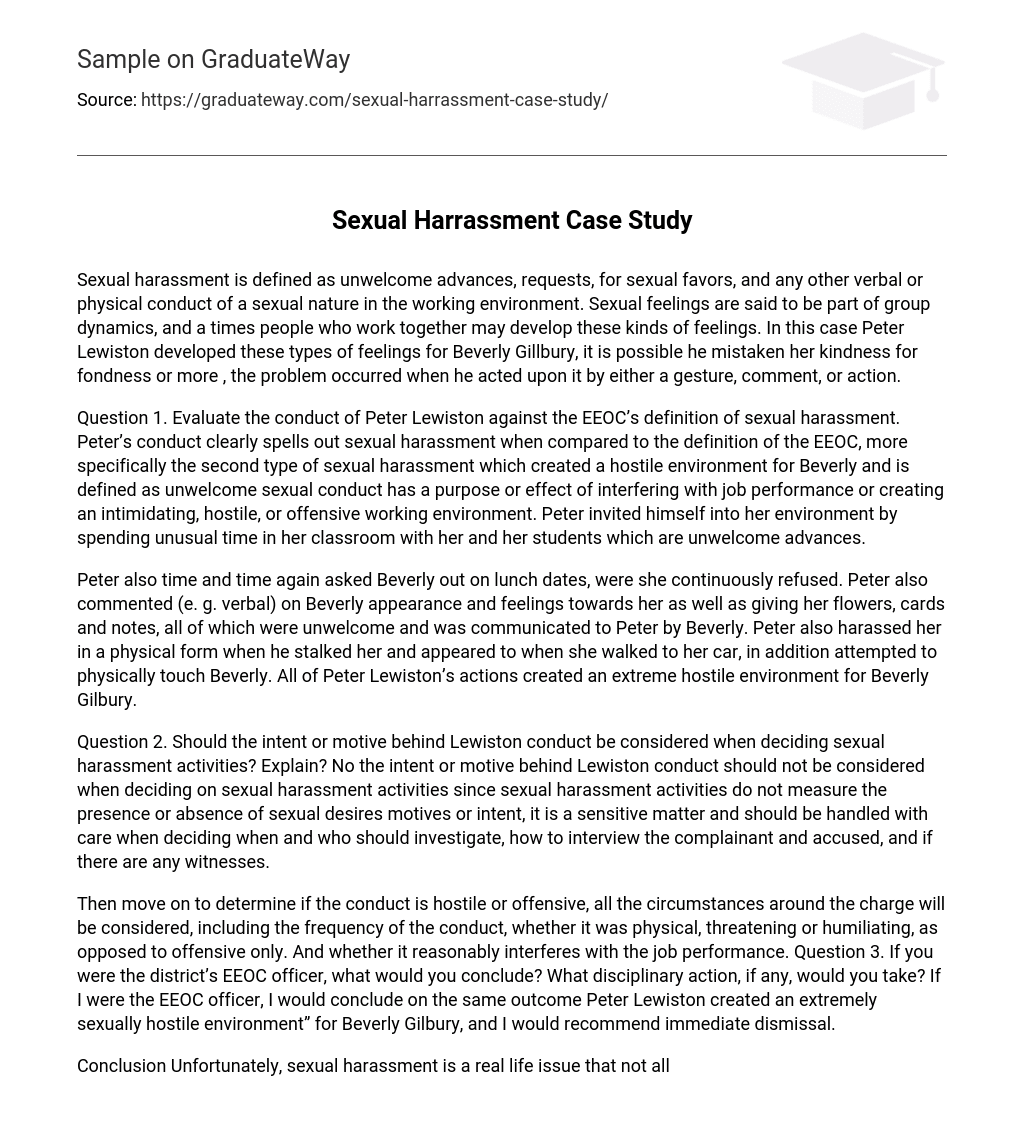Sexual harassment is defined as unwelcome advances, requests, for sexual favors, and any other verbal or physical conduct of a sexual nature in the working environment. Sexual feelings are said to be part of group dynamics, and a times people who work together may develop these kinds of feelings. In this case Peter Lewiston developed these types of feelings for Beverly Gillbury, it is possible he mistaken her kindness for fondness or more , the problem occurred when he acted upon it by either a gesture, comment, or action.
Question 1. Evaluate the conduct of Peter Lewiston against the EEOC’s definition of sexual harassment. Peter’s conduct clearly spells out sexual harassment when compared to the definition of the EEOC, more specifically the second type of sexual harassment which created a hostile environment for Beverly and is defined as unwelcome sexual conduct has a purpose or effect of interfering with job performance or creating an intimidating, hostile, or offensive working environment. Peter invited himself into her environment by spending unusual time in her classroom with her and her students which are unwelcome advances.
Peter also time and time again asked Beverly out on lunch dates, were she continuously refused. Peter also commented (e. g. verbal) on Beverly appearance and feelings towards her as well as giving her flowers, cards and notes, all of which were unwelcome and was communicated to Peter by Beverly. Peter also harassed her in a physical form when he stalked her and appeared to when she walked to her car, in addition attempted to physically touch Beverly. All of Peter Lewiston’s actions created an extreme hostile environment for Beverly Gilbury.
Question 2. Should the intent or motive behind Lewiston conduct be considered when deciding sexual harassment activities? Explain? No the intent or motive behind Lewiston conduct should not be considered when deciding on sexual harassment activities since sexual harassment activities do not measure the presence or absence of sexual desires motives or intent, it is a sensitive matter and should be handled with care when deciding when and who should investigate, how to interview the complainant and accused, and if there are any witnesses.
Then move on to determine if the conduct is hostile or offensive, all the circumstances around the charge will be considered, including the frequency of the conduct, whether it was physical, threatening or humiliating, as opposed to offensive only. And whether it reasonably interferes with the job performance. Question 3. If you were the district’s EEOC officer, what would you conclude? What disciplinary action, if any, would you take? If I were the EEOC officer, I would conclude on the same outcome Peter Lewiston created an extremely sexually hostile environment” for Beverly Gilbury, and I would recommend immediate dismissal.
Conclusion Unfortunately, sexual harassment is a real life issue that not all firms pay much attention to, there are daily sexual harassment incident happening out there that may go unreported because of fear or retaliation , or simply because the thought nothing may change their environment is adapted to by employees. In this case it seems Peter Lewiston was under the impression he did nothing wrong, does this suggest an illness or just un-educated? Sexual harassment training should be implemented and renewed and circulated amongst all firms to educate their employees.





